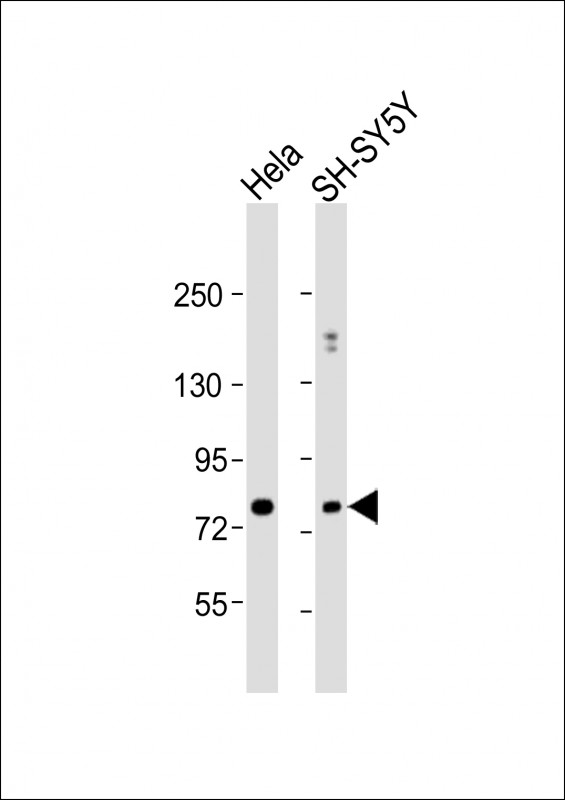

| WB | 1/1000 | Human,Mouse,Rat |
| IF | 咨询技术 | Human,Mouse,Rat |
| IHC | 咨询技术 | Human,Mouse,Rat |
| ICC | 技术咨询 | Human,Mouse,Rat |
| FCM | 咨询技术 | Human,Mouse,Rat |
| Elisa | 咨询技术 | Human,Mouse,Rat |
| Aliases | Vesicle-fusing ATPase, N-ethylmaleimide-sensitive fusion protein, NEM-sensitive fusion protein, Vesicular-fusion protein NSF, NSF |
| Entrez GeneID | 4905 |
| WB Predicted band size | 82.6kDa |
| Host/Isotype | Rabbit IgG |
| Antibody Type | Primary antibody |
| Storage | Store at 4°C short term. Aliquot and store at -20°C long term. Avoid freeze/thaw cycles. |
| Species Reactivity | Human, Mouse |
| Immunogen | This NSF antibody is generated from rabbits immunized with a KLH conjugated synthetic peptide between 668-696 amino acids from the C-terminal region of human NSF. |
| Formulation | Purified antibody in PBS with 0.05% sodium azide. |
+ +
以下是关于NSF抗体的3篇参考文献及其简要摘要:
1. **"SNAP receptors implicated in vesicle targeting and fusion"**
- **作者**:Söllner, T., Whiteheart, S.W., et al.
- **摘要**:该研究阐明了NSF蛋白与SNAP受体(SNAREs)在囊泡靶向和膜融合中的相互作用。通过使用NSF抗体阻断其ATP酶活性,揭示了NSF在解离SNARE复合体中的关键作用,为突触传递机制提供了实验依据。
2. **"N-ethylmaleimide-sensitive factor: a key regulator of platelet exocytosis"**
- **作者**:Whiteheart, S.W., et al.
- **摘要**:文章探讨了NSF在血小板分泌过程中的功能。通过抗体验证,发现抑制NSF会显著减少血小板颗粒内容物的释放,表明NSF在调控分泌通路中不可或缺。
3. **"In vitro reconstitution of synaptic vesicle fusion mediated by NSF and SNAPs"**
- **作者**:Hanson, P.I., Rothman, J.E., et al.
- **摘要**:研究利用体外重组系统模拟突触囊泡融合,通过NSF抗体干预实验证实,NSF的ATP依赖性活性是SNARE复合体循环和囊泡再融合的必要条件,为神经递质释放机制提供了直接证据。
这些文献均通过NSF抗体的实验手段,揭示了该蛋白在膜融合、分泌及神经信号传递中的分子机制。
NSF (N-ethylmaleimide-sensitive factor) antibody research stems from the protein's critical role in intracellular membrane trafficking. Discovered in the 1980s, NSF is a hexameric ATPase essential for disassembling SNARE complexes after vesicle fusion, enabling the recycling of synaptic vesicles and maintaining secretory pathways. Its function spans neurotransmitter release, hormone secretion, and organelle membrane dynamics.
Antibodies targeting NSF emerged as tools to study its molecular interactions, particularly in neuronal and endocrine systems. Immunoprecipitation and immunofluorescence studies using NSF antibodies helped map its binding partners, including α-SNAP and SNARE proteins. However, NSF antibodies also gained clinical relevance when autoantibodies against NSF were identified in rare autoimmune and paraneoplastic neurological disorders. These autoantibodies may disrupt vesicle cycling, contributing to synaptic dysfunction observed in conditions like encephalitis or cerebellar ataxia.
Recent studies explore NSF's potential links to neurodegenerative diseases, with antibodies aiding in detecting altered NSF expression in models of Alzheimer’s or Parkinson’s. Despite its ubiquitous expression, NSF antibody applications remain specialized, reflecting both its conserved cellular role and niche pathological implications. Ongoing research aims to clarify whether NSF autoantibodies are biomarkers or direct contributors to neurological pathologies.
×